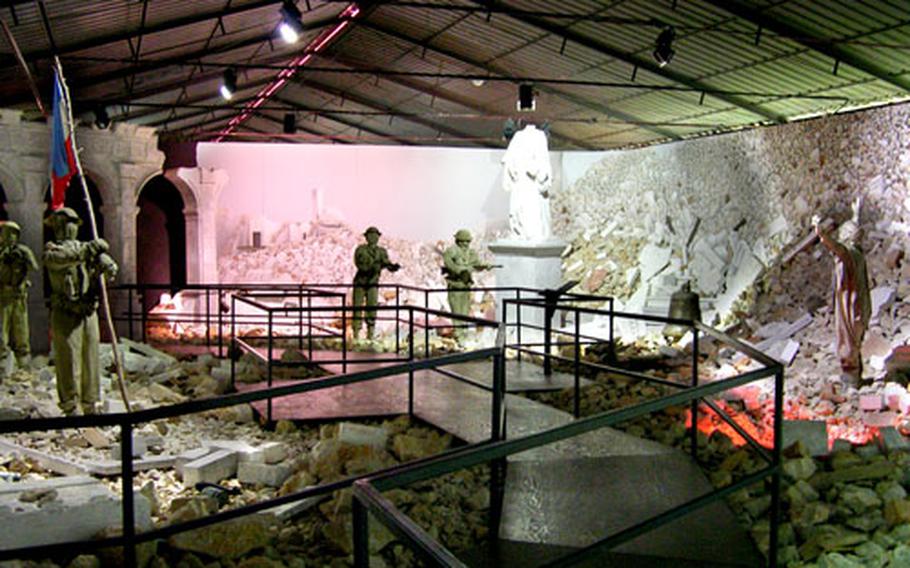
In one display at the Piana delle Orme museum, designed to look like the ruins of the abbey at Monte Cassino, life-sized mannequins dressed as German soldiers “surrender” to Allied troops. At least a dozen large displays depicting World War II scenes are featured at the museum. (Jason Chudy / S&S)
The Piana delle Orme museum is a great museum for learning about Italy’s participation in World War II.
It’s also a museum dedicated to telling how the Pontine Marshes, a low-lying area south of Rome, were drained and turned into farmland by Benito Mussolini in the 1920s.
And, it’s an old-toy museum.
Any way you look at it, the Piana delle Orme museum in Latina, Italy, about an hour’s drive north of Naval Support Activity Gaeta and about 2½ hours north of Naples, covers a lot of ground, both figuratively and literally, with large, detailed displays.
It’s a museum that, if you’re into old vehicles, could easily be Italy’s version of the Smithsonian Institution.
Piana delle Orme has enough stuff to keep an adult busy for hours. Plus, its many life-size dioramas with plenty of sounds and flashing lights will keep the younger crowd entertained at the same time.
Tucked away in an Italian farm field, the museum is housed in what looks like a string of old warehouses surrounding a grassy courtyard. The first look is deceiving.
Visitors walking into the first building — housing old toys and military models — can immediately see the amount of effort and detail that the museum has placed in its displays.
The toys range from old trains and cars — including Italian carabinieri car toys — to dolls. The military models include everything from aircraft carriers and battleships to the B-2 stealth bomber.
The second building holds life-size dioramas showing construction of the canals that helped drain the malarial Pontine Marshes. Large, descriptive plaques and display boards are in Italian, English and German, giving Americans a much better understanding of what they’re seeing.
Most of these large dioramas include oral narratives that are triggered by visitors. These, too, are in three languages, so if an American group is visiting, all someone has to do is press the button marked “English” and the narrative is all there in, well, plain English.
The military displays, which take up nearly half of the museum’s buildings, are very detailed and extremely well done. Two of the museum’s more unusual pieces are an amphibious Sherman tank that had been fished out of the ocean near Salerno, south of Sicily, and a P-40 Warhawk fighter plane that was forced to land in the water off the Anzio beach.
The pilot who landed the plane has been to the museum, and display boards explain the details (in three languages) of both the wartime landing and recovery less than 10 years ago.
While the Piana delle Orme museum is hard to find, it is more than worth a visit. Do not let its hefty 10 euros price tag for adults deter you from visiting.
And there is one other feature that makes it a good place to visit: It’s probably one of the few museums in Italy that doesn’t showcase old Roman pottery.
On the QT ...
DIRECTIONS: From Gaeta, take the Rome Road north to Terracina, where the road splits into SS 148 and SS 7 (Via Appia).
Follow SS 7 north about 10 miles until you come to a stoplight at SS 156 (signs show Latina and Borgo San Michele). Turn left toward Latina; at the next stoplight, turn left again.
About a mile down the road turn right (there’s a small, brown museum sign at the intersection) and Piana delle Orme is on the left a few hundred yards down the road.
COSTS: Adult tickets are 10 euros. Tickets for children 6 to 12 are 8 euros. Children younger than 6 are admitted free.
TIMES: The museum opens daily at 9 a.m. year-round. During the summer the museum closes at 6:30 p.m., except Sundays when it closes at 5 p.m. In winter, it closes at 4 p.m., and is closed all day on Christmas.
FOOD: There is a restaurant on site, but food also is available in nearby Latina. You also can take a picnic lunch, as there is a large area with tables and benches.
INFORMATION: The museum Web site features Italian, German and English versions. Information also is available by phone at 0773-258-708.
— Jason Chudy